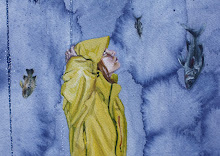 Look what I found–a heart-shaped piece of honeycomb! I like to pretend that I found it while I was walking in the woods. In Sweden. Specifically here. But in truth I found it while I was hauling our recycling out to the curb. But that's OK too–a little reminder of the wonders all around us.
Look what I found–a heart-shaped piece of honeycomb! I like to pretend that I found it while I was walking in the woods. In Sweden. Specifically here. But in truth I found it while I was hauling our recycling out to the curb. But that's OK too–a little reminder of the wonders all around us. We have a new neighbor living downstairs. She moved in this past weekend, and she seems very nice. I met her a couple of months ago, when she came to view the downstairs apartment and rang our bell by mistake. She seemed like the sort of person who could love this old, quirky house as much as we do, and I hoped she would be the one to move in. I wonder if the honeycomb heart belonged to her. Maybe it was accidentally dropped or discarded while the movers struggled with her furniture. That scenario would fit thematically with the fact that I also scavenged a little table from her trash.
Yesterday I finished this first illustration for the children's book I'm painting/writing:

I can't believe how quickly I completed this image. I'm usually an extremely slow worker. I was so stunned when I realized that the picture was finished that I wasn't sure what to do. Was I being unwittingly lazy? I got out some of my larger fine art paintings and made quality comparisons. But the illustration held up against them. So I ran and got Cat for some good, honest feedback. And she agreed (with very, very kind and encouraging words) that it was, indeed finished. Huzzah!
The actual execution of this image, from character studies and initial sketches to cutting it off the board and spray-fixing it, took me two days of work. That's only about 15 hours. Of course, that doesn't include the preceding two weeks of thinking and percolating. But still. One of my "fine art" paintings of the same size, similar look and equal amount of detailed rendering might take me around 80 hours from start to finish.
This discrepancy is obviously based on the differences between my fine art and illustration processes. When I create work slated for a gallery wall, my process is all about experimentation, and covering new, unexplored territory. And let me tell you, it can be pretty time consuming. It's a bit like getting yourself lost on purpose, and eventually having to find your way out again. In more concrete terms, I begin with a part of an image or a gesture (a figure, a setting, a strange phenomenon) with no clue about how I might develop or resolve it. As I work I respond to my initial imagery, adding more subjects, taking parts away, cutting, tearing, sewing, painting, until a new, intuitively generated story emerges.
Making this illustration was a different story altogether; I simply used the skills and techniques that I've developed through that slower "fine-arty" process, to create a narrative image that already existed in my head. What surprised me the most was that this process was just as lovely and juicy and interesting to me as that other, bumpier one. But they are dramatically different ways of working. Simply stated, it's easier/faster to find something when you consciously know what you're looking for. But isn't it delicious to wander and explore, and just see where you end up once you get there? I am mindful of the fact that for me and my work, neither of these two processes would exist without the other. And this gives me a happy sense of balance.





1 comment:
Oh, so interesting to read about these different processes. Maybe we all have a little of both of these with an emphasis one way or the other. Anyway, this illustration is absolutely magical! Can't wait to read the book!
Post a Comment